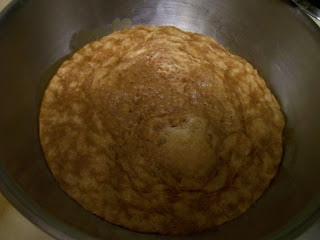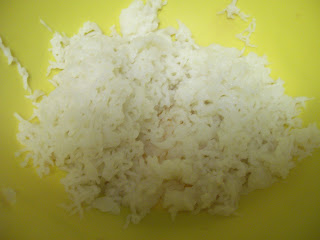The Challenge: Historical Sleuth. Research a vague recipe, or combine two or more recipes.
The Recipe: A very light Potato Bread.--Dry 2 pounds of fine flour, and rub into it a pound of warm mealy potatoes; add warm milk and water, with a sufficient quantity of yeast and salt, at the proper time; leave it 2 hours to rise in a warm corner, in winter; bake it in tin shapes, otherwise it will spread, as the dough will rise very light. It makes nice hot rolls for butter. An excellent tea or bun bread is made of it, by adding sugar, eggs, and currants.
Page 423-4 of Mrs. Hale's New Cook Book (1857) by Sarah J. Hale.
Date/Region: 1857 (1860, 1848). American
How Did You Make It: I started with the receipt above, and set about trying to figure out the proper amounts of yeast and salt. Also, what to do with the potatoes (boil, mince, mash?), as whole potatoes won't easily incorporate into a "light" bread.
So, I checked Mrs. Beeton's, and her take on potato bread is completely different: very little flour relative to the amount of potatoes, and no yeast at all. Mrs. Bradley's doesn't include potato bread, though there is a "potato yeast" receipt (more on that shortly). Fortunately, Catharine Beecher came to the rescue, with a more explicit version of Mrs. Hale's receipt:
Potato Bread--Rub a dozen peeled and boiled potatoes through a very coarse sieve, aim mix with them twice the quantity of flour, mixing very thoroughly. Put in a coffee-cup full of home-brewed, or of potato yeast, or half as much of distillery yeast, also a teaspoonful of salt. Add whatever water may be needed to make a dough as stiff as for common flour bread.--Miss Beecher's Domestic Receipt Book (1848) [Note, I also found this verbatim, three years earlier, in The Southern Cultivator, with options to add butter or eggs for a finer bread].
A System of Practical Medicine (1842) defines some common household measures, including that a coffee cup holds 4 oz when filled normally, or 5 oz when filled to the brim (a teacup is apparently 4 oz as well, but a "breakfast teacup" is 8 oz; tablespoons vary, but are defined as 1/2 oz).
So, that's 2 lbs of fine flour, 1 lb of warm, dry boiled potatoes which have been "riced"/"snowed" through a sieve (thanks comment-writers!), about 2 oz of potato yeast (could not find live baking yeast or any sort of brewer's/distillery yeast at the local stores), 1 tsp of salt, and an unspecified amount of water or milk.* Seems more do-able.
*I realized while it was rising that the amount of yeast/salt was given for 1 dozen potatoes, while the flour/potato quantities I was using were from the other receipt, in pounds. Since the 1 lb of potatoes was about 2 1/2 moderate russets, I'm hoping the second receipt assumed very small potatoes--else, there's going to be way too much yeast for the bread.
The potato yeast receipt in Mrs. Bradley's Housekeeper's Book (1860) calls for (an unspecified amount of) mashed potato, diluted with water to "the consistency of yeast"; to this is added 1/2 teacup (about 2 oz) molasses and 2 Tbsp (about 1 oz) of yeast, and it's all allowed to ferment near a warm fire until it stops. Based on this conversion chart, I think I'll need about 1 1/2 quarter-ounce packets of dry yeast--it's a modern substitute, but it's the best I can do at this time.
So, I started by peeling and boiling about 1 1/2 lbs of potatoes. When they were soft, I allowed them to drain (about 20 minutes), then took 8 oz of potato, mashed it with 1/4 cup milk, then added 1/4 cup of molasses and 3 3/8 tsp dry yeast. Having no fire, I set the yeast mixture in the oven at the lowest "warm" setting (under 200F) for half an hour.
Meanwhile, I started attempting to force the remaining potatoes through a colander. It sort of worked, but was very slow, so I ended up switching to the smaller side of a cheese-grater, which gave the same result rather faster. The potatoes were boiled very soft, and basically became a glutinous, sticky mass while being worked. On the upside, no lumps.
With the potatoes done, I measured out 2 lbs of flour, and mixed them together by hand, adding 1 tsp salt, 1 cup of milk, 1/4 cup of the yeast mixture, and finally 1/2 cup water. After kneading by hand for about ten minutes, the dough was fairly incorporated, so I covered it and set it to rise for 2 hours (once again using the ultra-low oven setting to make a "warm corner").
Without explicit instructions from this point, I just kneaded the second time, put it into pans, let it rise another 60 minutes, then baked at 350F for about 40 minutes. I opted not to make rolls, as I lacked the recommended "tins" (muffin rounds, I assume).
Time to Complete: About 4.5 hours, including rising and baking time (and forty minutes of rubbing sticky potatoes over a cheese grater).
Total Cost: All ingredients were on hand.
How Accurate Was It: The main modern intrusion was using the active dry yeast for the "yeast" in the potato yeast, as previously noted. I did some guessing on quantities (amount of potato in yeast, proportion of salt/yeast to flour/potato), but as those were historic ambiguities, I'm not counting them against the dish's accuracy.
How Successful Was It: Tastes like home-made bread. It's not particularly potato-y, though if I concentrate I can tell that there's *more* to it than my usual bread recipe.
As the receipt promised, it's nice and light, and tastes great with butter.





Om nom nom. That looks delicious. My recipe also used riced potatoes, and I found that baked potatoes allowed themselves to get pushed through my strainer pretty easily. I opted for the mesh strainer over my colander, as my colander has very few holes. But with them being baked, I was able to basically rub the inside of the skin along the mesh to get all the flesh out, and it was pretty dry and behaved well.
ReplyDeleteBut grating you say? Hmmmmm. New ways to work with potatoes are always useful!
Would you say the work into make potato bread made it worth while? Or does it seem more like the "huh I have extra potato... let's throw it in bread dough so it doesn't go to waste" kind of cooking?
-- Tegan
Your baked potatoes sound better behaved than my boiled ones--I'll need to try that next time ricing is in order. Unfortunately, even with the straining and drying, the boiled potatoes retained a fair amount of moisture, so it was less "grating" and more "extruding".
ReplyDeleteI wouldn't say the effort made much if any difference to taste or texture. I suspect "using up leftovers" or "potatoes are cheaper than white flour" might be the reasoning behind this one.